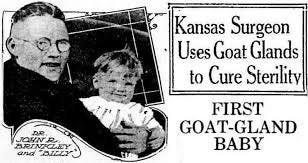The Hormone Hustle
From Goat Glands to Modern Myths
There’s a doctor — white coat and all — holding a scalpel beside a young male goat.
He’s about to implant that goat’s testicle into your scrotum.
For that, you’ll pay the equivalent of ten thousand dollars — cash.
Meet Dr. John R. Brinkley, America’s original hormone hustler.
In the 1920’s he promised to cure impotence and restore youth by transplanting goat glands into men.
He had a hospital, a radio station, and the swagger of a prophet.
He even claimed Hollywood stars and heavyweight champion Jack Dempsey were among his “success stories.”
Dempsey denied it, but the myth sold better than the truth.
Brinkley’s secret wasn’t medicine; it was marketing.
Like all hucksters, he used medical words; endocrine rejuvenation, vitality. Just enough so that the less educated would be impressed. He made millions in the 1920’s and even in the depression.
Sound familiar?
Today, testosterone clinics are running by replacing goats with hormone balancing centers, peptide injections and stem cell cocktails.
Same promise: longer life, better sex, faster recovery — all out of pocket.
There are real hormone clinics, places where board certified physicians, endocrinologists treat hormone deficiency. But they are not promising a fountain of youth, they are correcting an issue.
How We in Medicine Helped Create the Mess
When the Women’s Health Initiative (WHI) hit headlines in 2002, the message stuck:
“Hormones cause cancer and heart attacks.”
It wasn’t that simple. But that was the headline, and suddenly doctors stopped prescribing medicine for hormone replacement.
The original WHI data came from older women, years past menopause, many already at higher risk for cardiovascular disease.
But nuance doesn’t make front pages — fear does.
Doctors got scared. Women stopped asking.
And into that silence stepped celebrities and marketers.
Suzanne Somers became the new face of hormone therapy, selling “bioidentical” pellets as the secret to staying forever young.
Women wanted relief. Medicine went quiet.
That’s on us.
What We Know Now
Modern evidence paints a different story:
Starting menopause hormone therapy (MHT) around menopause is the best treatment for hot flashes, night sweats, and sleep loss.
It also helps maintain bone density, preventing the fractures that can destroy independence — or life.
For women with premature or surgical menopause, estrogen replacement is protective, not dangerous.
Used properly, hormone therapy relieves suffering.
Used indiscriminately, it just funds the next Brinkley.
If you want a clear, science-based reference, I recommend Dr. Jen Gunter’s The Menopause Manifesto — one of the best education tools out there. And she is here on substack - click here
Men’s hormone therapy has its place — but also its limits.
✅ Who needs it:
Men with documented low testosterone (under 300 ng/dL on two morning tests) and clear symptoms — low libido, fatigue, anemia, or muscle loss.
⚠️ Who doesn’t:
Men with normal levels who just want to “optimize” or “reclaim youth.”
Testosterone replacement can restore energy and improve mood — but it’s not a miracle.
Too much thickens the blood, raises clot risk, worsens sleep apnea, and kills fertility.
And here’s the big truth the clinics won’t tell you:
A shot or a cream won’t build muscle if you don’t move it.
Hormones can amplify effort — they can’t replace it.
Bone Loss: The Silent Killer
Osteoporosis sounds boring until you fracture a hip.
After 65, a hip fracture increases your chance of dying within a year by 20–30%, higher for men.
Half never regain independence.
That’s why maintaining bone density through hormone therapy when indicated, strength training, and nutrition isn’t vanity — it’s survival.
Memory, Mood, and Marketing
Despite what some clinics claim, hormone therapy doesn’t boost memory or prevent dementia.
What helps your brain are the basics:
Exercise
Sleep
Mediterranean-style diet
Blood pressure and cholesterol control
In other words, the Five M’s:
Muscle, Mobility, Mediterranean Eating, Mindful Rest, and Measured Medicine.
🚢 The Longevity & Healthspan Cruise — August 2026
We’ll explore all of this — the science and the hype — at sea.
The problem with most longevity is that it is woo - not science. And while people will pay Dr. Attia $100,000 for longevity, it isn’t that difficult. We make modern science simple.
The Longevity & Healthspan Cruise sails the second week of August 2026 through the Mediterranean.
You’ll live the Five M’s every day:
Morning movement and strength sessions with our onboard exercise lead
Mediterranean-style meals and cooking demos with a famous Food Network chef, judge, and fellow podcaster.
Evidence-based lectures on hormones, nutrition, longevity, and health span.
Mindful rest and recovery sessions overlooking the Mediterranean.
Paid subscribers get first dibs on cabins and the exclusive shore-excursion dinners with me and our chef.
We’re finalizing our faculty lineup now — experts in exercise, nutrition, sleep, and hormone science.
🔒 Paid Subscriber Section: Behind the Hormone Curtain
Let us go deeper, deeper into what works, what doesn't, and how modern longevity medicine fits into all this.



